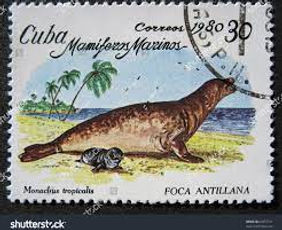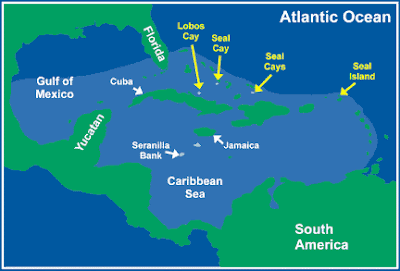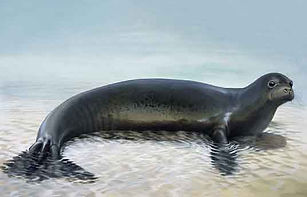Creature
Fast Facts
Introducing you to extinct species.

THE CARIBBEAN
MONK SEAL
1. The Caribbean monk seal was 7.5 - 8 feet long and could weigh up to 600 pounds. 2. They were first discovered by Christopher Columbus in 1494 near Hispaniola, where he referred to them as “sea wolves” in his journal. 3. The Caribbean monk seal is the only extinct member of the ‘pinniped’ family which includes seals, seal lions, and walruses. 4. The Caribbean monk seal nasal mite, which lived in the seal’s nasal passage also went extinct at the same time. 5. The Caribbean Monk Seals got their names from a fold of fatty skin around their necks which reminded fishermen of the religious monks back in Europe. 6. The Caribbean Monk Seal was one of three monk seal species. The Hawaiian monk seals (600 or so left today) and Mediterranean monk seals (about 1,100) are both critically endangered today. 7. They were brown with short fore flippers with claws and sometimes had algae growing on them. 8. They were curious and had no fear of people making them easy targets for food and fur. 9. Colonists in the area used this oil to light their lamps and to lubricate machinery. It was reported by sugar plantation owners in 1688 that hundreds of monk seals were killed every day to keep their machines running smoothly. 10. The last reported sighting of a Caribbean Monk Seal was in 1952 in Serranilla Bank between Jamaica and Nicaragua. 11. Interestingly they were not put on the endangered species list until 1967 and weren't officially declared extinct until 2008 when an expedition to find any remaining Caribbean Monk Seals turned up empty. 12. The Caribbean monk seal is one of the '12 Angry Animals' in a Captain Planet episode as well as a focal point for an episode of Extinct or Alive on Animal Planet.
Extinction
Cometh
Facing the light at the end of the tunnel
EXTINCTION DATE
1952
When Europeans first arrived on the east coast of North America, there were an estimated 300,000 Caribbean monk seals in the Caribbean sea. They ranged throughout the Gulf of Mexico, thriving in the warm Caribbean Sea. Columbus was the first European explorer to describe them in his journal in 1494, as he killed 8 of them upon his arrival on Hispaniola. In 1513, Ponce de Leon, while looking for the Fountain of Youth in Florida, killed several Caribbean monk seals. As the colonies expanded in the new world, so did the need to kill more Caribbean monk seals. In 1668, sugar plantations killed hundreds of seals a day to use their blubber to oil their machinery. In the 1700’s fishermen killed the seals in great numbers for two reasons. First, it eliminated competition for fish. Secondly, the seal oil was used to light their lamps for hunting at night. By the 1850’s their numbers plummeted and it was no longer cost effective to hunt for the monk seals. Even though they were not frequently hunted for food or oil, the population in the Caribbean continued to put a demand for more fish. As fishing practices improved, the fish population in the Caribbean monk seal’s range dropped. This led to many Caribbean monk seals simply dying of starvation. In 1897, the first Caribbean monk seal was taken into captivity at the New York Aquarium and did quite well. In 1922, a monk seal was spotted in the Florida Keys. In 1926 & 1932 monks seals were spotted off the coast of Texas. The last monk seal killed was in Pedro Cays in 1949. The last confirmed Caribbean monk seal sighting was in Serranilla Bank, Columbia in 1952. 1952 marks the accepted extinction date for the Caribbean monk seal. In 1967 they were put on the endangered species list. There have been some unconfirmed sightings since then, but the Caribbean monk seal was officially deemed extinct in 2008. Although Jurassic Park is fiction, scientists are working on several de-extinction projects. In fact, in 2003 scientists did bring back the extinct Pyrenean ibex, a type of wild goat, for 7 minutes before it died, showing de-extinction is possible. The Caribbean monk seal might be a candidate. Scientists would potentially use DNA from the few remaining skins and specimens at museums. If the Caribbean monk seal was brought to life, could it ever be reintroduced to its native homeland in the Caribbean? The United States has made many strides in protecting endangered species through many initiatives like the US Endangered Species Act of 1972, but the Caribbean monk seal might find competition with fisherman and a lack of food from overfished waters to be a potential hurdle to overcome. The two other types of monk seals, the Hawaiian and Mediterranean, left in the world are critically endangered, so the outcome for the Caribbean monk seal might be similar. If the Caribbean monk seal ever was brought back from extinction, it seems like it would have many o obstacles to overcome to survive in the wild. Most likely, breeding programs could be set up at zoos and aquariums to help the population expand. During the early 1900’s the New York Aquarium did have success with Caribbean monk seals in captivity.
NEW STORY
A vacation back to my old home might just hit the spot. It’s not that I don’t enjoy the splendors of paradise. I just want to go back and spread my wings, I mean flippers. It’ll be nice to spend some time on the warm sand, basking in the sun, feeling the cool breeze hit my face as I leap out of the crystal blue seas. It’ll be nice being back in my warm snot cocoon at a consistent 98.24℉ (That’s how warm seal snot is. Look it up.) Who am I? I am the Caribbean monk seal. The only member of the seal family to once dwell in the warm, wonderful Caribbean Sea. My kind even met Christopher Columbus on his first ocean crossing to the “New World”. It wasn’t new. It had always been there, but once old Columbus settled down, life in the Caribbean would never be the same. Don’t forget me. Who am I? I am the one who never got much respect. I am the Caribbean monk seal nasal mite. The guy who lived in this seal’s nose. Columbus never took notice of me. In fact, I only was ever noticed by one scientist, but that was about to change.
More to Explore
All answers lead to more questions
Photo taken at New York Aquarium in 1910
Image from Wikipedia


The seal gets its name due to the way its neck resembles the hoods of European monks
Image from Wikipedia
Caribbean monk seal
nasal mite that only lived in this seal's nose
Image from Wikipedia




Caribbean monk seal range
Image from SaveEarth.World
Memorial Stamp
Image from Shutterstock
Captain Planet
Image from Retro Oasis

3 monk seal species
Image from Peppermint Narwhal on Facebook

'12 Angry Animals' episode of Captain Planet
Image from Retro Oasis

A Gap in Nature
Image from Amazon

A painting of the Caribbean monk seal by Peter Schouten
image from A Gap in Nature



